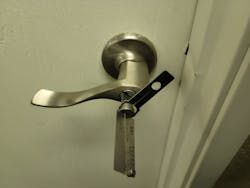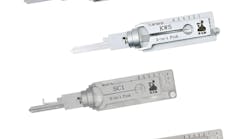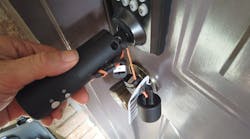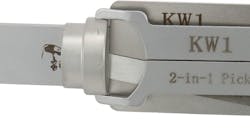Zhi Qin Li is a name that isn’t often recognized in the United States, but his mark on the automotive locksmith industry in the past decade or so has been immeasurable.
Mr. Li, the father of Original Lishi, began by producing manual pick tools and direct-read decoders but caught traction when he combined the two concepts into what we know today as the 2-in-1 decoder. These engineering marvels work well, because they provide automotive locksmiths with the ability to feel their way through the subtleties of the picking process accurately and then measure the proper depths of a keyway accurately by reading the space between the contact point of the wafer and the cylinder wall. Whether laser track, edge cut or whatever that newer Audi keyway is, Lishi most likely has a solution for almost every modern lock that you might encounter in the automotive world.
But why should automotive locksmiths have all the fun? Even though the average residential lock doesn’t contain the same razor-sharp edges as does the interior of a car door, it would be nice for nonautomotive locksmiths to be able to pick and decode common residential and commercial locks with similar ease. In 2019, Original Lishi provided just that opportunity. It ventured into the residential and commercial realms by making tools for the most common Kwikset (KW1 and KW5) and Schlage (SC1 and SC4) keyways, eventually expanding the line to include BEST, Master and American locks. Some locks covered in these lines are built so as not to be serviceable. Others have a service procedure that requires a working key.
The Basics
For anyone reading who isn’t already familiar with how Lishi tools work, it’s all based on a concept called “positional lockpicking.” The tools have a lifter arm attached to a pivot that interacts with the lock on one side, the handle on the other and a pointer near the handle side. The pointer corresponds to a grid printed on the reading pane, which provides the user with an accurate reading of not only the space that the tool is interacting with, but the depth of cut after the lock is picked.
When decoding traditional residential and commercial spring tumbler locks, keep in mind that after the lock is picked, the spring will be captured in the bible with the top pins, unlike automotive, where the construction of the locks always leave some level of springiness when picked. You’re looking only to kiss the cylinder wall with the pin you’re probing. There won’t be any spring-back resistance, and you should take extra care to not push beyond the proper reading.
It’s an obvious observation but worth noting that the tools are designed to work in the specific locks that they were designed for. You technically might be able to use a six-cut pick in a five-cut lock, but how the tool is braced might cause it to flex or bend unnaturally — and in the worst cases, to break.
In addition, some of these tools also might have a bias in the direction that they favor, so picking clockwise versus counterclockwise might cause the tool to flex in a way that binds the lifter arm and makes picking exponentially more difficult. Keep your plug spinner handy!
With those basics in mind, let’s take a look at the current lineup of commercial and residential Lishi tools. I’ll provide tips, tricks and feedback from my experiences with them.
KW1/KW5
These Lishi tools spawned the new venture into residential and commercial realms. They’re relatively straightforward to use, applying the regular “if it sticks, it picks” motto beyond the aforementioned disclaimer about springiness after the lock is picked.
Beyond the original intended purposes of picking traditional pin-tumbler locks, users also reported success on older generations of the Kwikset SmartKey cylinder, although some also claim that they damaged their tools slightly, so attempt at your own risk. Using a thin sidebar shim with the KW1 tool will get you into some more of the SmartKey cylinders out there, but it’s probably better to use LockTech’s new SmartKey Decoder for that application.
Another fun use (albeit, perhaps a little obscure at this point) can be extracting Titan cores without having to cut a notched key — just pick, turn, remove your tool and pull the lock.
SC1/SC4
The Schlage tools are really where a lot of residential locksmiths take notice of Lishi. Sure, anyone can pick a Kwikset cylinder with their eyes closed and an arm tied behind their back, but Schlage … Sometimes, those can be a problem. I recall many formative late-night calls where I’d find myself switching between my pick gun, manual picks and bump keys for some of the more problematic examples, much to the annoyance of many an apartment-complex neighbor.
The Schlage Lishi tools provide users with reliable methods to pick these locks by giving a direct visual graph as to where a user is probing and by giving direct feedback. Aside from the occasional security pin that might trip you up, with some simple practice, these tools work just as quickly and easily as their automotive counterparts.
KW1-L/SC1-L/SC4-L
These tools are variations of the regular KW1, SC1 and SC4 tools but with the lifter pointer and reading pane on the opposite side of the tool. Although this might be more convenient for lefty locksmiths, the real intent is to make it easier to use in situations where the lock might orient the tool upside-down or in an awkward manner (too close to a reciprocal wall or door jamb).
While we’re on the subject of comfort, it’s worth noting that all tools listed in this article have handle assemblies that can be flipped by using the included Allen wrench. Sometimes there are situations where you might find yourself against a door jamb or something of the like, and this is a feature that just adds a little more usability to the tools. Simply loosen the screw, remove the collar/tension arm, and reinstall in reverse orientation from how it shipped.
BE2-6/BE2-7
BE2 is Original Lishi’s answer to the BEST A keyway, available in six- and seven-pin models. This tool works well, although it might be one of the most difficult to use out of the entire Lishi lineup. The juice is worth the squeeze, however, if you work on these systems with any regularity, particularly compared with more-destructive (brute force) methods. Because of tight tolerances, the potential for security pins (and the way that the master pins react to being picked) sometimes creates massive headaches for the locksmith.
Here’s an example of the potential difficulty with these locks: A gentleman brought a sample to one of our Original Lishi classes earlier this year, and none of the instructors (myself, Jason Frank, Bill Youngson) was able to get it picked within the 20–30 minutes that we attempted it. It isn’t impossible, but it can be tough.
If you’re asking whether the BE2 Lishi will pick to control, it will! How the lock was pinned will dictate whether it’s something that happens naturally. Some of the locks I picked rolled right into control, while others required a few run-throughs and copious amounts of experimentation.
This is the only keyway (so far) that I believe might have a component of luck versus being able to be defeated on pure skill alone. Hopefully, you’ll develop a better feel for it than I have. Honestly, the biggest tips I can give here are to use a light touch, practice profusely and don’t get discouraged. If you’re trying specifically to cut a new control key for a system and find yourself unable to get the lock rolled over, you might have better results if you try moving around to different cylinders in the system (if possible).
M1/MS2 and AM5
I grouped these tools because they’re used primarily on Master Lock and American Lock padlocks and they pick fairly similarly.
Both work well, although they can be a little finicky to tension properly. I’ve found that light tension on the cylinder typically is the ticket to success, but you have to find a happy middle ground between tensioning the cylinder while overcoming the re-centering springs that often are found in these locks.
It might not seem like a huge deal to pick padlocks or make keys to them, but using a Lishi tool often gains a “wow factor” from your customer that just isn’t there with more-intrusive or destructive means of attack. Sure, anyone can take an angle grinder to a shackle, but if you have a customer who has a bunch of padlocks that are keyed alike, you look like a hero when you save that customer from replacing or rekeying them all.
In closing, much like their automotive counterparts, the residential and commercial Lishi tools function fantastically and make short work of their reciprocal locks with a little training and practice. If you haven’t already, I implore you to check out these tools and find out what the fuss is all about.
Chris Lira is an automotive locksmith and a giant Lishi nerd. He serves as a project manager for the AutoProPAD line of programmers and the Triton key machine at American Key Supply.





